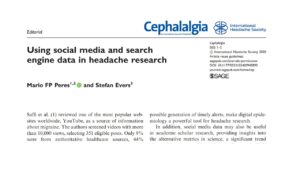Foi publicado um editorial na revista Cephalalgia, comentando a respeito da informação existente sobre dores de cabeça, enxaqueca nas redes sociais.

First Published July 23, 2020 Editorial
Article first published online: July 23, 2020
 Mario FP Peres1, 2, Stefan Evers3
Mario FP Peres1, 2, Stefan Evers3
Corresponding Author:
Mario FP Peres, Instituto de Psiquiatria do HCFMUSP, Hospital Albert Einstein, R Turquia 26, SP 01449-050, São Paulo, Brazil. Email: ma********@***il.com
Saffi et al. (1) reviewed one of the most popular websites worldwide, YouTube, as a source of information about migraine. The authors screened videos with more than 10,000 views, selecting 351 eligible posts. Only 9% were from authoritative healthcare sources, 44% focused on complementary and alternative medicine. This is not surprising, especially since many try to make a business out of their internet presentation. Maybe, the high presentation of complementary and alternative medicine also reflects the needs and the wishes of our patients which we, as scientific doctors, cannot address.
Social media content, not only on YouTube, but also Twitter, Facebook, Instagram, and others should be curated by the medical societies. Their algorithm affecting which posts users see should weight institutional sources more heavily. The medical societies, on the other hand, should produce more content directed to the lay public. The International Headache Society (IHS) has therefore decided to participate in social media. IHS is active on Twitter and Facebook, and the journal Cephalalgia is also going more and more online. It is, however, difficult to cooperate with the big players in this field such as Facebook or Twitter because we cannot touch the right of everybody to place his/her opinion on the internet. So, it has still to be debated how medical societies such as IHS can have influence on the content of social media as long as it is not their own content. IHS has also given a grant to a research project on the impact of distributing scientific headache information on the impact factor of scientific journals.
This paper also raises the discussion on a new research topic: Digital epidemiology. Internet tools, social media and search engine query data (Google trends), may provide significant health-related information about certain populations, diseases and therapies used, leading to an ongoing paradigm shift in clinical epidemiology (2). Global internet availability, different keywords used in each language, and internet searches carried out for non-medical purposes are critical limitations. The availability of real-time data, leading to possible generation of timely alerts, make digital epidemiology a powerful tool for headache research.
In addition, social media data may also be useful in academic scholar research, providing insights into the alternative metrics in science, a significant trend observed in scientometric studies (3). Due to the limitations of impact factor and traditional citations, alternative metrics are broadening the scope of scientific publications considering their reach to the general public.
Furthermore, at some time, these internet-based tools will be integrated into headache treatment, and not only by video consulting. The first apps are meanwhile available in which headache
patients can write down their headache diary and where they get treatment and behavioral advices created by algorithms (not to say artificial intelligence) and not by a doctor. These algorithms are crucial and must be designed by professional experts. In Germany, for example, the authorities have even decided that health apps, including headache apps (after being checked for scientific quality), can be prescribed by a doctor and that the installation of such an app will be paid for by the public health insurance. It has already been shown that treatment algorithms for primary headache disorders based on scientific guidelines result in the same patient outcome as a GP consultation (4,5). The future will show whether replacement of personal consulting by internet-based treatment approaches, at least in chronic headache disorders, will be accepted by the patients.
Beside all these advantages, we should however not forget the disadvantages of this development. One problem has already been discussed. The quality of the contents in social media cannot be controlled. Patients are not able to decide for themselves whether this is useful information or whether this is business by a charlatan. Another problem is that many parts of the world are still not connected to the internet and many patients in poorer countries do not have access to such media. If scientific societies and health authorities focus on internet-based information and treatment, we would cut off many sufferers from migraine treatment. Finally, patients could come to the wrong conclusions from what they read on the internet, resulting in wrong self-diagnoses and self-treatment. If they rely only on internet sources of information, there would be no institution for correcting a diagnosis or changing treatment advice.
In summary, it is important to carefully and critically analyze the development of headache medicine on the internet, as has been done by this Danish study
